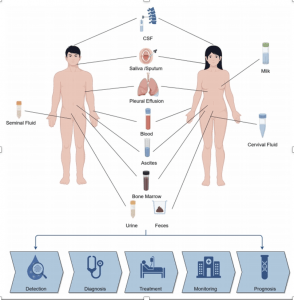In a recent review, researchers highlight how early cancer detection could be revolutionize by liquid biopsy, a minimally invasive diagnostic tool. By examining tumor-derived materials like circulating tumor DNA (ctDNA), cell-free DNA (cfDNA), circulating tumor cells (CTCs), and exosomes in bodily fluids, liquid biopsy facilitates real-time cancer diagnosis and observing (Figure 1). This innovative approach addresses the limitations of conventional tissue biopsies and unlocks new paths for precision oncology.

Figure 1: Liquid biopsy workflow illustrating how tumor-derived biomarkers are released into body fluids and analyzed for cancer detection.
Key Findings
- Liquid biopsy uses tumor-derived genetic and molecular markers from blood, urine, saliva, or cerebrospinal fluid for early identification and detection of cancer.
- Insights into tumor burden, tissue of origin, and real-time variations in cancer biology can be provided by cfDNA and ctDNA. The patterns of ctDNA tumor-specific mutations and methylation are especially valuable for diagnosis and treatment monitoring
- Metastatic potential can be detected by CTCs. Although CTCs are minimal in bodily fluid, molecular profiling can still be achieved through machineries such as microfluidic technologies and single-cell sequencing
- Nucleic acids and proteins from tumor cells are carry by exosomes. Their stability and abundance in fluids make them promising diagnostic targets, although isolation remains challenging.
- Next-generation sequencing (NGS) and digital PCR are advancing the sensitivity and specificity of biomarker detection.
- The feasibility of using liquid biopsy especially for early-stage diagnosis of various forms of cancers such as lung, breast, colorectal, prostate, and gastric cancers have been demonstrated by clinical trials
Clinical Impact
- Early cancer screening can be transformed by liquid biopsy through:
- Reducing the need for invasive biopsies
- Allowing frequent, real-time monitoring
- Enhancing detection of minimal residual disease
- Supporting personalized therapy decisions
- These benefits are particularly valuable in low- and middle-income countries, where traditional diagnostics may be inaccessible or cost-prohibitive.
Future Directions
- Researchers highlight the need to:
- Improve detection sensitivity (especially for early-stage cancers)
- Standardize procedures for sample processing and analysis
- Validate biomarker panels in large-scale clinical trials
- Incorporate liquid biopsy with other diagnostic tools such as imaging
- With persistent innovations, liquid biopsy could become a universal, first-line cancer screening tool, presenting a path to earlier interventions and improved survival outcomes.
Journal article: Liang, X., Tang, Q., Chen, J., & Wei, Y. 2025. Liquid Biopsy: A Breakthrough Technology in Early Cancer Screening. Cancer Screening and Prevention.
Summary by Ezediuno Louis Odinakaose










